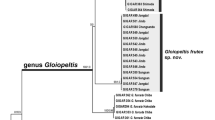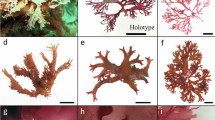Abstract
Intertidal Ulva mats occur annually in winter and spring in the **angshan Bay (29°26′–29°34′ N, 121°27′–121°50′ E) of China. Thousands of tons of Ulva biomass have been harvested as edible seaweeds for human consumption for several decades in this region. This investigation was designed to quantify Ulva microscopic propagules associated with the mat, identify species composition, and to analyze intra-species relationships using three molecular markers. Phylogenetic analysis based on the nuclear encoded rDNA internal transcribed spacer region, the plastid encoded large subunit of the ribulose 1,5-bisphosphate carboxylase gene, and the 5S rDNA spacer region showed that the mat was principally composed of Ulva prolifera and Ulva flexuosa. Their propagules were detected in both the water column and sediment. Based on phylogenetic analyses of the 5S rDNA spacer region, mat samples of U. prolifera and U. flexuosa were genetically distinct from the green tide samples in the Yellow Sea and U. flexuosa samples from Jiangsu coasts, respectively, revealing that isolated geographical position of the **angshan Bay might result in the maintenance of a distinct Ulva population. The results demonstrate that high-resolution DNA markers have great potential in identification and discrimination at and below the species level.







Similar content being viewed by others
References
Blomster J, Bäck S, Fewer DP, Kiirikki M, Lehvo A, Maggs CA, Stanhope MJ (2002) Novel morphology in Enteromorpha (Ulvophyceae) forming green tides. Am J Bot 89:1756–1763
Cai YH, Zhang HB, **ang YT (2006) Evolution and causes of formation of Gymnodinium sanguineum bloom in **angshan Bay. Ocean Dev Manag 5:116–118 (in Chinese)
China Network Television (CNTV) (2011) http://sannong.cntv.cn/program/zhifu**g/20110323/111001.shtml. Accessed 23 March 2011
Dong LX, Su JL (1999) Numerical study of water exchange in **angshangang Bay. II. Model application and water exchange study. Oceanol Limnol Sin 30(5):465–470 (in Chinese with English abstract)
Duan W, Guo L, Zhu S, Sun D, Zhu S, Chen X, Zhu W, Xu T, Chen C (2012) Morphological and molecular characterization of free-floating and attached green macroalgae Ulva spp. in the Yellow Sea of China. J Appl Phycol 24:97–108
Hayden HS, Waaland JR (2002) Phylogenetic systematics of the Ulvaceae (Ulvales, Ulvophyceae) using chloroplast and nuclear DNA sequences. J Phycol 38:1200–1212
Hayden HS, Blomster J, Maggs CA, Silva PC, Stanhope MJ, Waaland JR (2003) Linnaeus was right all along: Ulva and Enteromorpha are not distinct genera. Eur J Phycol 38:277–294
Hiraoka M, Ichihara K, Zhu W, Ma J, Shimada S (2011) Culture and hybridization experiments on an Ulva clade including the Qingdao strain blooming in the Yellow Sea. PLoS One 6(5):e19371. doi:10.1371/journal.pone.0019371
Imchen T (2012) Recruitment potential of a green alga Ulva flexuosa Wulfen dark preserved zoospore and its development. PLoS One 7(3):e32651. doi:10.1371/journal.pone.0032651
Kimura M (1980) A simple method for estimating evolutionary rate of base substitutions through comparative studies of nucleotide sequences. J Mol Evol 16:111–120
Leliaert F, Zhang X, Ye N, Malta EJ, Engelen AH, Mineur F, Verbruggen H, De Clerck O (2009) Identity of the Qingdao algal bloom. Phycol Res 57:147–151
Leskinen E, Pamilo P (1997) Evolution of the ITS sequences of ribosomal DNA in Enteromorpha (Chlorophyceae). Hereditas 126:17–23
Leskinen E, Alstrőm-Rapaport C, Pamilo P (2004) Phylogeographical structure, distribution and genetic variation of the green algae Ulva intestinalis and U. compressa (Chlorophyta) in the Baltic Sea area. Mol Ecol 13:2257–2265
Liu F, Pang SJ, Chopin T, Xu N, Shan T, Gao S, Sun S (2010a) The dominant Ulva strain of the 2008 green algal bloom in the Yellow Sea was not detected in the coastal waters of Qingdao in the following winter. J Appl Phycol 22:531–540
Liu F, Pang SJ, Xu N, Shan T, Sun S, Hu X, Yang J (2010b) Ulva diversity in the Yellow Sea during the large-scale green algal blooms in 2008-2009. Phycol Res 58:270–279
Liu F, Pang SJ, Zhao XB, Hu CM (2012a) Quantitative, molecular and growth analyses of Ulva microscopic propagules in the coastal sediment of Jiangsu province where green tides initially occurred. Mar Environ Res 74:56–63
Liu F, Pang SJ, Chopin T, Gao S, Shan T, Zhao XB, Li J (2012b) Understanding the recurrent large-scale green tide in the Yellow Sea: temporal and spatial correlations between multiple geographical, aquacultural and biological factors. Mar Environ Res. doi:10.1016/j.marenvres.2012.10.007
Lü HQ, Chang KM, Shi GD (2009) Circulation and distribution of nitrogen and phosphorus in **angshan Bay, China. Oceanol Limnol Sin 40(2):138–144 (in Chinese with English abstract)
Luo QJ (2009) Change of macroalgae in fixed floats in **angshan Bay. J Ningbo Univ (NSEE) 22(4):467–471 (in Chinese with English abstract)
Luo MB, Liu F, Xu ZL (2012) Growth and nutrient uptake capacity of two co-occurring species, Ulva prolifera and Ulva linza. Aquat Bot 100:18–24
Mareš J, Leskinen E, Sitkowska M, Skácelová O, Blomater J (2011) True identity of the European freshwater Ulva (Chlorophyta, Ulvophyceae) revealed by a combined molecular and morphological approach. J Phycol 47:1177–1192
O’Kelly CJ, Kurihara A, Shipley TC, Sherwood AR (2010) Molecular assessment of Ulva spp. (Ulvophyceae, Chlorophyta) in the Hawaiian Islands. J Phycol 46:728–735
Pang S, Liu F, Shan T, Xu N, Zhang Z, Gao S, Chopin T, Sun S (2010) Tracking the algal origin of the Ulva bloom in the Yellow Sea by a combination of molecular, morphological and physiological analyses. Mar Environ Res 69:207–215
Santelices B, Hoffmann AJ, Aedo D, Bobadilla M, Otaíza R (1995) A bank of microscopic forms on disturbed boulders and stones in tide pools. Mar Ecol Prog Ser 129:215–228
Schories D (1995) Sporulation of Enteromorpha spp. (Chlorophyta) and overwintering of spores in sediments of the Wadden Sea, island Sylt, North Sea. Neth J Aquat Ecol 29:341–347
Schories D, Reise K (1993) Germination and anchorage of Enteromorpha spp. in sediments of the Wadden Sea. Helgol Meeresunters 47:275–285
Shimada S, Yokoyama N, Arai A, Hiraoka M (2008) Phylogeography of the genus Ulva (Ulvophyceae, Chlorophyta), with special reference to the Japanese freshwater and brackish taxa. J Appl Phycol 20:979–989
Sun JZ, Yu H, Chen WD, Jiang XO (2006) The records of the benthic seaweeds in Zhejiang province. J Zhejiang Ocean Univ (Nat Scie) 25(3):312–321 (in Chinese with English abstract)
Sun S, Wang F, Li CL, Qin S, Zhou MJ, Ding LP, Pang SJ, Duan DL, Wang GC, Yin BS, Yu RC, Jiang P, Liu ZL, Zhang GT, Fei XG, Zhou M (2008) Emerging challenges: massive green algae blooms in the Yellow Sea. Nature Precedings. doi:10101/npre.2008.2266.1
Sun D, Sun C, Duan W, Shi J, Li B, Wang D (2011) Combined morphological and molecular approach to the Ulva (Chlorophyta, Ulvophyceae) in the Ningbo Area. J Anhui Agri Sci 39(12):6936–6938 (in Chinese with English abstract)
Tamura K, Dudley J, Nei M, Kumar S (2007) MEGA4: Molecular Evolutionary Genetics Analysis (MEGA) software version 4.0. Mol Biol Evol 24:1596–1599
Tan IH, Blomster J, Hansen G, Leskinen E, Maggs CA, Mann DG, Sluiman HJ, Stanhope MJ (1999) Molecular phylogenetic evidence for a reversible morphogenetic switch controlling the gross morphology of two common genera of green seaweeds, Ulva and Enteromorpha. Mol Biol Evol 16:1011–1018
Thompson JD, Higgins DG, Gibson TJ (1994) CLUSTAL W: improving the sensitivity of progressive multiple sequence alignment through sequence weighting, position-specific gap penalties and weight matrix choice. Nucl Acids Res 22:4673–4680
Tian XL, Huo YZ, Chen LP, He JH, Zhang JH, Jia R, Liu H, Wang JH, Xu R, Yang JQ, Hu X, Fang JM, Ma JH, He PM (2011) Molecular detection and analysis of green seaweeds from Rudong coasts in Jiangsu Province. Chin Sci Bull (Chinese Ver) 56:309–317
Worm B, Lotze HK, Sommer U (2000) Propagule banks, herbivory and nutrient supply control population development and dominance patterns in macroalgal blooms. Oikos 89:46–58
Worm B, Lotze HK, Sommer U (2001) Algal propagule banks modify competition, consumer and resource control on Baltic rocky shores. Oecologia 128:281–293
Yotsukura N, Kawai T, Motomura T, Ichimura T (2002) Tandem 5S ribosomal RNA genes and spacer region sequences of three Japanese Laminaria species. J Appl Phycol 14:233–239
Yotsukura N, Kawai T, Kawashima S, Ebata H, Ichimura T (2006) Nucleotide sequence diversity of the 5S rDNA spacer in the simple blade kelp genera Laminaria, Cymathaere and Kjellmaniella (Laminariales, Phaeophyceae) from northern Japan. Phycol Res 54:269–279
Zhang HB, Cai YH, **ang YT (2005) Study on the phytoplankton and HAB in **angshan Bay. Mar Sci Bull 24(1):92–96 (in Chinese with English abstract)
Zhang LX, Jiang XS, Cai YH (2008) Characteristics of nutrient distributions and eutrophication in seawater of the **angshan Harbor. Mar Env Sci 27(5):488–491 (in Chinese with English abstract)
Zhang LX, Zhao M, Fu XQ, Cai YH (2010) The variation trend of seawater environment of **angshan Harbor and study of their R/S forecasting in recent 22 years. Trans Oceanol Limnol 1:115–120 (in Chinese with English abstract)
Zhang X, Xu D, Mao Y, Li Y, Xue S, Zou J, Lian W, Liang C, Zhuang Z, Wang Q, Ye N (2011) Settlement of vegetative fragments of Ulva prolifera confirmed as an important seed source for succession of a large-scale green tide bloom. Limnol Oceanogr 56:233–242
Acknowledgments
The authors thank Ma Jiahai, Liu Yimeng, and local fishermen for their assistance in sampling. This investigation is financially supported by Qingdao Municipal Science and Technology Commission (10-4-1-14-hy, 11-3-1-3-hy), a project from Science and Technology Commission of Qingdao Shinan District (2011-5-030-QT) and a project from Qingdao National Oceanographic Center (QNOC).
Author information
Authors and Affiliations
Corresponding author
Rights and permissions
About this article
Cite this article
Liu, F., Pang, S. & Zhao, X. Molecular phylogenetic analyses of Ulva (Chlorophyta, Ulvophyceae) mats in the **angshan Bay of China using high-resolution DNA markers. J Appl Phycol 25, 1287–1295 (2013). https://doi.org/10.1007/s10811-012-9955-5
Received:
Revised:
Accepted:
Published:
Issue Date:
DOI: https://doi.org/10.1007/s10811-012-9955-5




